 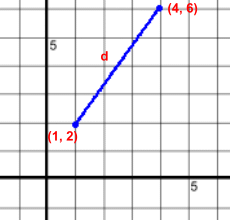 For simplicity, we're starting with points joining a line in the first quadrant. All the numbers will be positive.
For simplicity, we're starting with points joining a line in the first quadrant. All the numbers will be positive.You can't count squares to find distance d when the line segment isn't horizontal or vertical. However, the grid is made from horizontal and vertical lines, so we can construct a right triangle ... 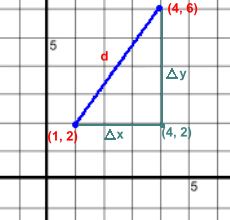 Here is is. How far is it between (1, 2) and (4, 6)?
Here is is. How far is it between (1, 2) and (4, 6)? The sides meet at a right angle, at the point (4, 2) Find the side lengths by counting squares, or using the formulas: Δx = |4 - 1| = |3| = 3 Δy = |6 - 2| = |4| = 4 Now we can use the Pythagorean Theorem: d2 = 32 + 42 = 9 + 16 = 25 d = √(25) = 5 Let's try another one: Find the distance between (0, 1) and (4, 3) 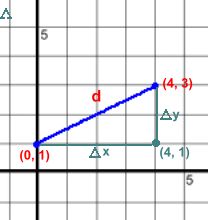 The sides meet at a right angle, at the point (4, 1)
The sides meet at a right angle, at the point (4, 1)Find the side lengths by counting squares, or using the formulas: Δx = |4 - 0| = |4| = 4 Δy = |3 - 1| = |2| = 2 Now we can use the Pythagorean Theorem: d2 = 42 + 22 = 16 + 4 = 20 d = √(20) = 4.5 (rounded to 1 dp) For an exact value, we leave the √(20), but simplify it: d = √(20) = √(4)·√(5) = 2·√(5) Let's try one where some of the coordinates have negative values: Find the distance between (-3, 3) and (3, -5) 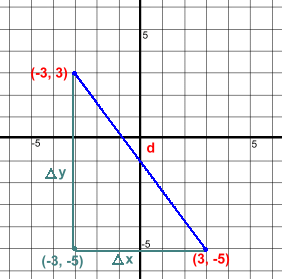 The sides meet at a right angle, at the point (-3, -5)
The sides meet at a right angle, at the point (-3, -5)Find the side lengths by counting squares, or using the formulas: Δx = |3 - -3| = |6| = 6 Δy = |3 - -5| = |8| = 8 Now we can use the Pythagorean Theorem: d2 = 62 + 82 = 36 + 64 = 100 d = √(100) = 10 You may be wondering why we're using the formulas to calculate Δx and Δy. There will be a reason. But first let's do one more example using the Pythagoreaan Theorem. Think about the number of steps necessary: How long is the line segment joining (-4, -3) and (1, 0)? 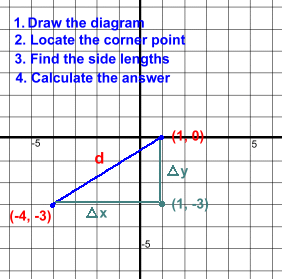
The sides meet at a right angle, at the point (1, -3) Find the side lengths by counting squares, or using the formulas: Δx = |-4 - 1| = |-5| = 5 Δy = |-3 - 0| = |-3| = 3 (Notice that we subtracted backwards this time) d2 = 52 + 32 = 25 + 9 = 34 d = √(34) = 5.8 (rounded to 1 dp) This method isn't very difficult, but it's a lot of work. Let's look at a much quicker way to find the distance between two points, or the length of a line. Go on to page three for the Distance Formula ... |